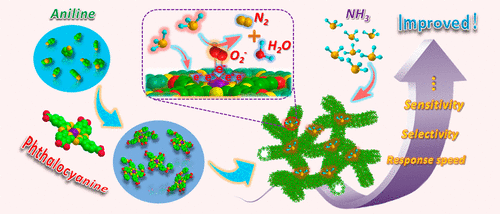当前位置:
X-MOL 学术
›
Chem. Mater.
›
论文详情
Our official English website, www.x-mol.net, welcomes your
feedback! (Note: you will need to create a separate account there.)
Manipulating Polyaniline Fibrous Networks by Doping Tetra-β-carboxyphthalocyanine Cobalt(II) for Remarkably Enhanced Ammonia Sensing
Chemistry of Materials ( IF 7.2 ) Pub Date : 2017-11-02 00:00:00 , DOI: 10.1021/acs.chemmater.7b03645 Hao Wu 1 , Zhimin Chen 1 , Jialin Zhang 1 , Feng Wu 1 , Chunying He 1 , Zhiyu Ren 1 , Yiqun Wu 1, 2
Chemistry of Materials ( IF 7.2 ) Pub Date : 2017-11-02 00:00:00 , DOI: 10.1021/acs.chemmater.7b03645 Hao Wu 1 , Zhimin Chen 1 , Jialin Zhang 1 , Feng Wu 1 , Chunying He 1 , Zhiyu Ren 1 , Yiqun Wu 1, 2
Affiliation

|
Manipulating the morphology and protonic acid doping of polyaniline (PANI) is significant for optimizing its NH3-sensing. Herein, tetra-β-carboxyphthalocyanine cobalt(II) (TcPcCo) acted as the dopant and structure-directing agent simultaneously to fabricate the uniform fibrous network-like PANI (PANI-TcPcCo hybrids) by a one-step polymerization at low temperature. During the reaction process, the protonic acid groups in TcPcCo not only induced the aniline monomers polymerizing into one-dimensional nanofibers (consist of both solid and hollow cylinders) with abundant tiny protuberances on the surface but also successfully doped into PANI. The resulting PANI-TcPcCo hybrids displayed the enhancement in terms of the good conductivity, the large gas adsorption capacity, and the unobstructed channels for the electron and gas transport. The central metal atoms of TcPcCo present the strong and selective affinity to NH3. Meanwhile, the deep-seated conversion of PANI’s molecular structure after exposure in NH3 could occur due to the presence of TcPcCo. Thus, the PANI-2.5TcPcCo sensor showed the excellent NH3-sensing performance at room temperature, including an ultrahigh and fast response (802.7% and ∼17.0 s for 100 ppm of NH3), a very low detection limit of 10 ppb (about 5000 parts of human olfaction limit of detection, 55 ppm), and superior NH3-sensing stability and selectivity. The strategy developed here provides a reliable and valid way to synthesize functional PANI-based hybrids with unique morphology and appropriate doping, which are able to be extended to other areas.
中文翻译:

通过掺入四-β-羧基酞菁钴(II)操纵聚苯胺纤维网络以显着增强氨感测
操纵聚苯胺(PANI)的形态和质子酸掺杂对于优化其NH 3具有重要意义-感知。本文中,四-β-羧基酞菁钴(II)(TcPcCo)同时充当掺杂剂和结构导向剂,以通过低温一步聚合来制造均匀的纤维状网状PANI(PANI-TcPcCo杂化物)。在反应过程中,TcPcCo中的质子酸基团不仅诱导苯胺单体聚合成一维纳米纤维(由实心和空心圆柱体组成),表面具有大量微小的突起,而且还成功地掺入了PANI中。所得的PANI-TcPcCo杂化物在良好的电导率,大的气体吸附能力以及电子和气体传输的通畅通道方面表现出增强作用。TcPcCo的中心金属原子对NH 3具有强烈的选择性亲和力。同时,由于存在TcPcCo,在NH 3中暴露后,可能发生PANI分子结构的深层次转化。因此,PANI-2.5TcPcCo传感器在室温下显示出出色的NH 3感测性能,包括超高和快速响应(对于100 ppm NH 3,响应为802.7%和约17.0 s ),检测限很低,为10 ppb(约5000份人类嗅觉检测限(55 ppm),以及出色的NH 3感测稳定性和选择性。此处开发的策略提供了一种可靠且有效的方法,可以合成具有独特形态和适当掺杂的功能性PANI基杂种,并可以扩展到其他领域。
更新日期:2017-11-03
中文翻译:

通过掺入四-β-羧基酞菁钴(II)操纵聚苯胺纤维网络以显着增强氨感测
操纵聚苯胺(PANI)的形态和质子酸掺杂对于优化其NH 3具有重要意义-感知。本文中,四-β-羧基酞菁钴(II)(TcPcCo)同时充当掺杂剂和结构导向剂,以通过低温一步聚合来制造均匀的纤维状网状PANI(PANI-TcPcCo杂化物)。在反应过程中,TcPcCo中的质子酸基团不仅诱导苯胺单体聚合成一维纳米纤维(由实心和空心圆柱体组成),表面具有大量微小的突起,而且还成功地掺入了PANI中。所得的PANI-TcPcCo杂化物在良好的电导率,大的气体吸附能力以及电子和气体传输的通畅通道方面表现出增强作用。TcPcCo的中心金属原子对NH 3具有强烈的选择性亲和力。同时,由于存在TcPcCo,在NH 3中暴露后,可能发生PANI分子结构的深层次转化。因此,PANI-2.5TcPcCo传感器在室温下显示出出色的NH 3感测性能,包括超高和快速响应(对于100 ppm NH 3,响应为802.7%和约17.0 s ),检测限很低,为10 ppb(约5000份人类嗅觉检测限(55 ppm),以及出色的NH 3感测稳定性和选择性。此处开发的策略提供了一种可靠且有效的方法,可以合成具有独特形态和适当掺杂的功能性PANI基杂种,并可以扩展到其他领域。











































 京公网安备 11010802027423号
京公网安备 11010802027423号